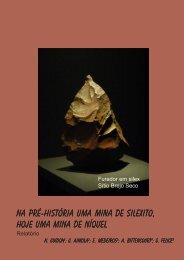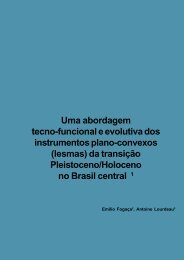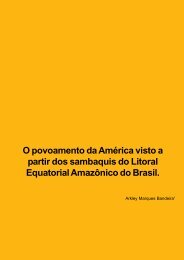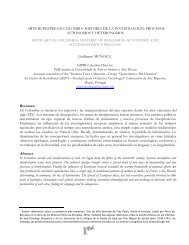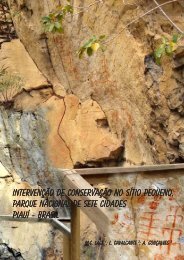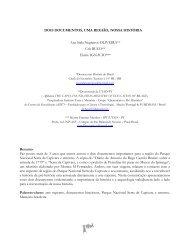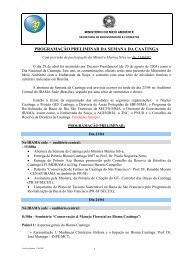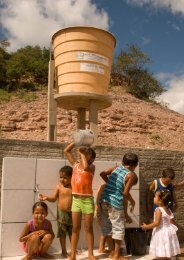Untitled - Fundação Museu do Homem Americano
Untitled - Fundação Museu do Homem Americano
Untitled - Fundação Museu do Homem Americano
You also want an ePaper? Increase the reach of your titles
YUMPU automatically turns print PDFs into web optimized ePapers that Google loves.
Semejanzas y diferencias en el arte rupestre del valle de Guasapampa y cordón de Serrezuela<br />
(Cór<strong>do</strong>ba, Argentina): análisis compara<strong>do</strong> de las representaciones y sus contextos de<br />
producción y uso<br />
Andrea Recalde & Sebastián Pastor, Argentina<br />
El propósito de este trabajo es presentar algunos resulta<strong>do</strong>s de las investigaciones desarrolladas en<br />
diferentes sectores del valle de Guasapampa y en la sierra de Serrezuela (Prov. de Cór<strong>do</strong>ba, Argentina).<br />
En dichas microrregiones hemos <strong>do</strong>cumenta<strong>do</strong> materialidades que nos permiten afi rmar diferentes<br />
modalidades de ocupación y de significación del paisaje. Uno de los rasgos culturales más frecuentes<br />
es el arte rupestre. A los fines de su análisis consideramos preciso el estudio de los paneles en sí<br />
mismos (técnica, motivos, diseños y temas), así como sus condiciones de emplazamiento en el paisaje<br />
(visibilidad; recursos asocia<strong>do</strong>s) y, fundamentalmente, los contextos de producción y uso en que se<br />
integran las representaciones. Los datos obteni<strong>do</strong>s de la comparación de todas estas variables nos<br />
autoriza a proponer la realización de prácticas sociales antagónicas entre las secciones Norte y Sur de<br />
la microrregión objeto de estudio.<br />
Desarrollo paralelo de signos salva<strong>do</strong>s y amplifica<strong>do</strong>res de senti<strong>do</strong><br />
Léo Dubal, Suíça<br />
38<br />
By representing one thing by something else with iconical graphemes, homo sapiens won the challenge<br />
of adding to his artefactual compositions more sense with less signs A selection of examples of this sign<br />
saving strategy will be presented, not only in carved Rock Art, but also on various material supports by<br />
using appropriate processes, i.e.<br />
- rock (painting or engraving) - lifted stones “menhir” (sculture); - textile (painting, knitting); - terra-cotta<br />
(sculpture); - paper (argentical & numerical photo, cartoon)<br />
The use of Iconical Graphemes allows one to merge the “figurative” (or “phonetical”) value of a sign to its<br />
(often unexpected) attributed sense in a composition. The added-value brought by this sense amplifi er<br />
results in an obvious sign saving, i.e. the backbone of all historical writing: - plane & iconical (hieroglyphic),<br />
then - linear & verbal (ideographic, syllabic, alphabetical, alphanumerical, etc). This parallel development<br />
reflects indeed the way each cerebral hemispheres complement each others.<br />
Del pensamiento a la piedra y de la piedra al pensamiento.Memoria y manifestaciones<br />
rupestres en el valle de Sibun<strong>do</strong>y, corre<strong>do</strong>r milenario entre Andes y selva (Putumayo,<br />
Colombia)<br />
Ana Lucía Flórez Páez, Colômbia<br />
Producto de un intenso trabajo de campo y de los relatos proporciona<strong>do</strong>s por los indígenas inga y kamsá,<br />
actuales habitantes del valle de Sibun<strong>do</strong>y, Putumayo (Colombia), este trabajo devela un número eleva<strong>do</strong><br />
de manifestaciones rupestres que, si bien se sabe fueron esculpidas en un pasa<strong>do</strong> remoto, aún hoy, se<br />
reconocen y son parte vital de los usos y explicaciones indígenas sobre su mun<strong>do</strong> cotidiano, cosmológico<br />
y político, de ahí que el énfasis hecho en este trabajo se base, más que en las piedras mismas, en el<br />
conocimiento del pasa<strong>do</strong> aún activo en la memoria, en las formas de apropiación de unas piedras cuyas<br />
tallas han trascendi<strong>do</strong> sus formas para albergar otros significa<strong>do</strong>s, se trata de ubicarlas desde el hoy en<br />
espacios reales de coexistencia pasa<strong>do</strong>-presente.<br />
The Four Technical Categories Of The Peruvian Rock Art<br />
Gori Tumi Echevarría López, Perú<br />
For the author, the Peruvian rock art is an “archaeological artifact” which has intrinsic particular properties<br />
that distinguish it respect to the wide range of conventionally recognized archaeological artifacts. Like a<br />
regular artifact, this material includes a legal status of state protection but specially the right to a technical<br />
treatment of scientific intervention.<br />
Even though in Peru the academic study of the rock art (called quilca in the native language) rise at the<br />
beginning of the XX century, this evidence is not currently considered a regular archaeological artifact<br />
been marginalized from the cultural studies that focus mainly on other archaeological evidences. This<br />
FUMDHAMentos IX




